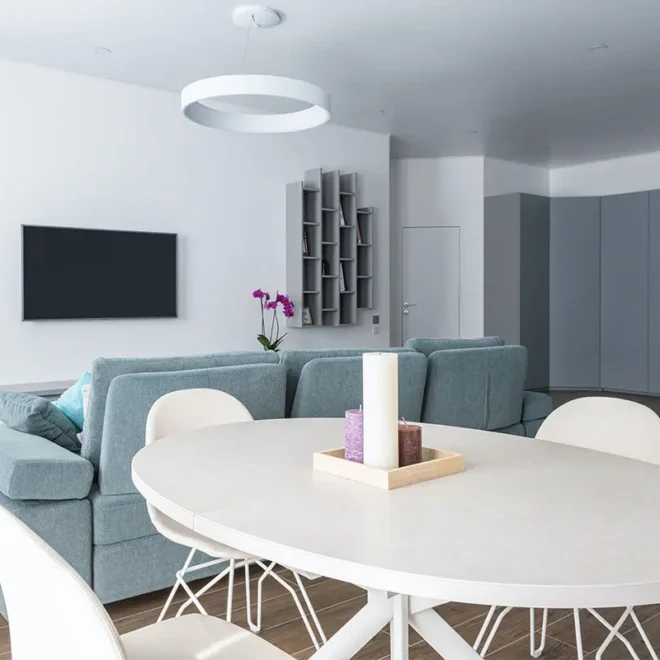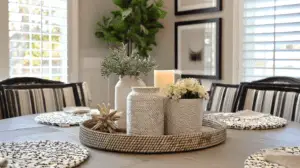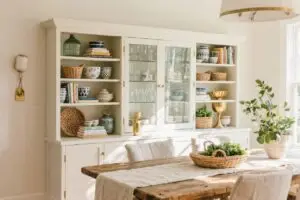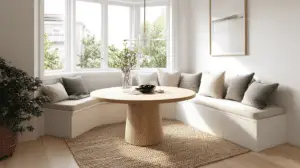Small spaces can still accommodate dining tables. Creative apartment dwellers have mastered the art of carving out eating nooks. Here are 20 clever layout ideas for your small living-dining combo.
These ideas will inspire you to add a table stylishly. From using rugs to define spaces to choosing multipurpose furniture, our suggestions will help. You’ll create a functional, inviting combo that maximizes every square foot.
Key Takeaways:
- Utilize area rugs to define distinct living and dining zones
- Opt for a floating furniture arrangement to maximize flexibility
- Use an L-shaped couch as a soft divider in narrow spaces
- Choose a round dining table for a more intimate dining experience
- Incorporate multipurpose furniture to save space and enhance adaptability
- Maximize vertical space with shelving and tall, narrow cabinets
- Harness the power of mirrors to make the room appear brighter and more open
Utilizing Area Rugs to Distinguish Spaces
Area rugs can transform a small living room dining room combo. They visually separate spaces without physical barriers. By placing complementary rugs strategically, you create distinct functional zones that flow seamlessly.
Selecting Complementary Rugs

Choose area rugs that complement each other in color, texture, and style. This ensures a cohesive look that unites the two spaces. Consider selecting rugs within the same color family or with coordinating accent colors.
Pick rugs with similar patterns or textures for continuity. Align your rug choices with the overall style of your space.
- Opt for rugs within the same color family or with coordinating accent colors
- Choose rugs with similar patterns or textures to create a sense of continuity
- Consider the overall style of your space and select rugs that align with that aesthetic
Defining Functional Zones
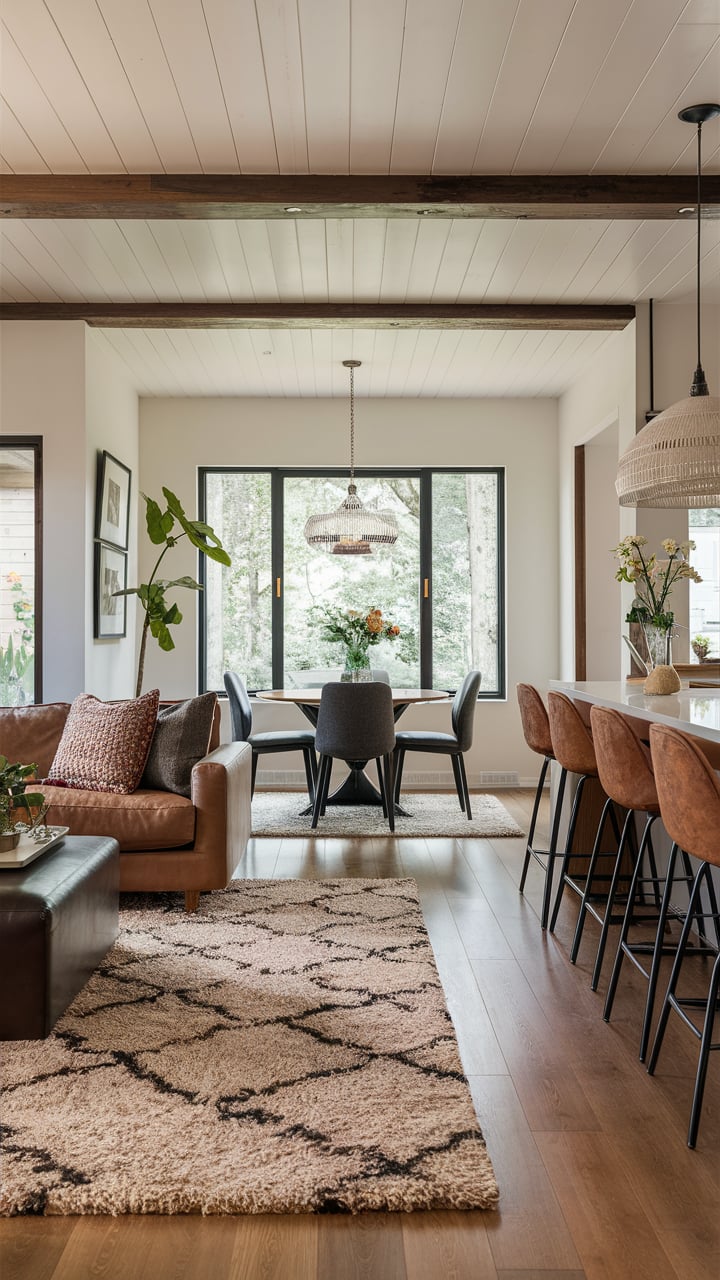
Rug placement helps define functional zones in your combo room. For the living area, choose a plush, comfortable rug that invites relaxation. In the dining space, select a flatter, durable rug that withstands chair movement.
Position your rugs to create a natural flow between areas. They should subtly indicate where one space ends and another begins. Careful rug placement maximizes practicality and aesthetic appeal in your combo room.
Floating Furniture Arrangement
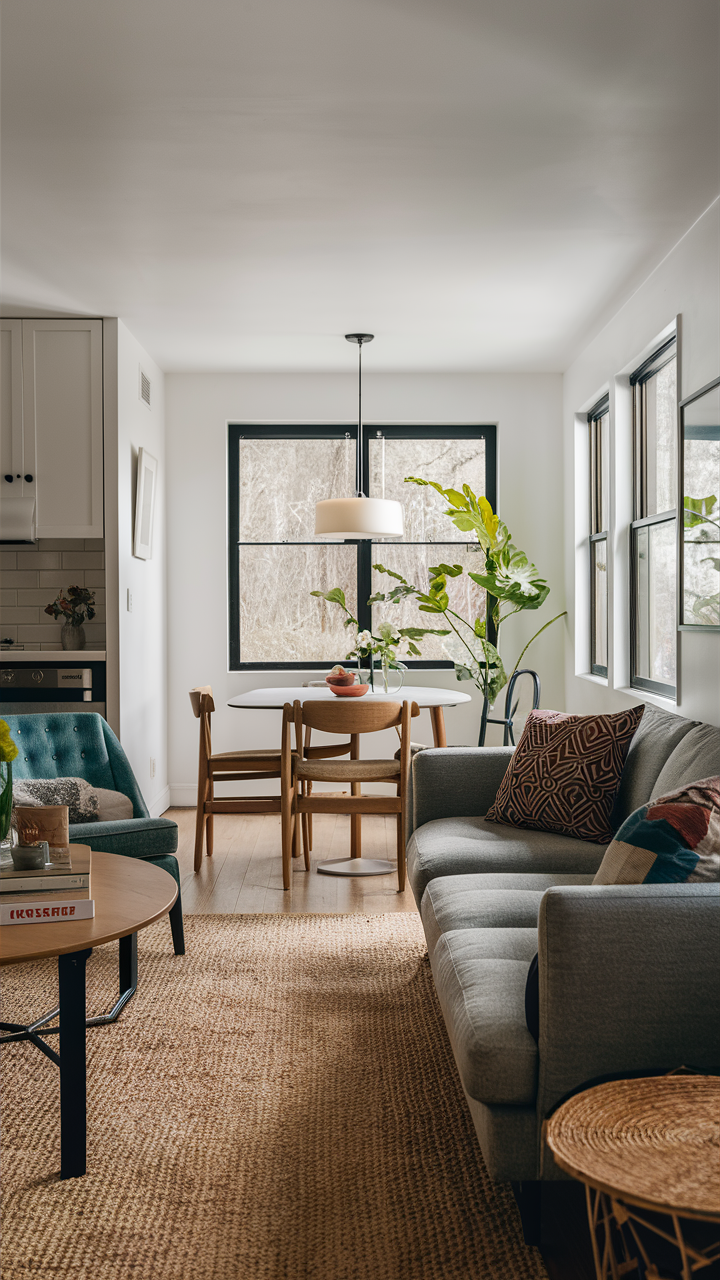
A floating furniture arrangement can transform a small living room dining room combo. Position sofas, chairs, and tables away from walls to create flexible space. This technique makes the room appear larger and more open.
Place the sofa with its back towards the dining area to divide spaces naturally. Choose slim-profile pieces to maintain an uncluttered look. Leave enough space between the sofa and dining table for easy movement.
Enhance openness in your combo room with these elements:
- Floating shelves: These wall-mounted shelves provide storage and display space without taking up valuable floor area.
- Wall-mounted lighting: Sconces or pendant lights that are affixed to the walls can illuminate the room without encroaching on the limited square footage.
- Streamlined furniture: Choose pieces with clean lines and minimal embellishments to maintain a spacious feel.
A floating furniture arrangement maximizes functionality in your small combo room. This approach allows for flexible use of space. You can easily adapt the room to your changing needs and preferences.
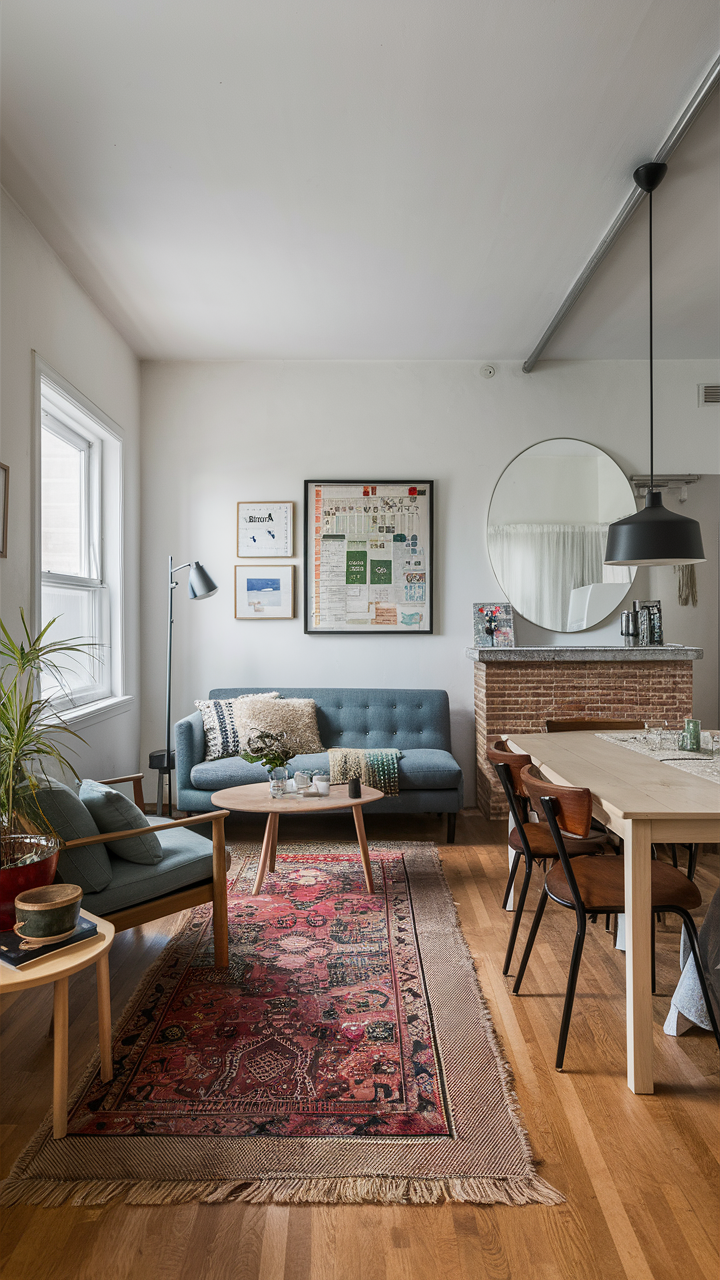
L-Shaped Couch as a Soft Divider
An L-shaped couch can be a great solution for narrow living room dining combos. It provides ample seating and defines the living area without closing it off. This versatile furniture piece creates a soft divide between the two spaces.
Positioning the Couch for Optimal Flow
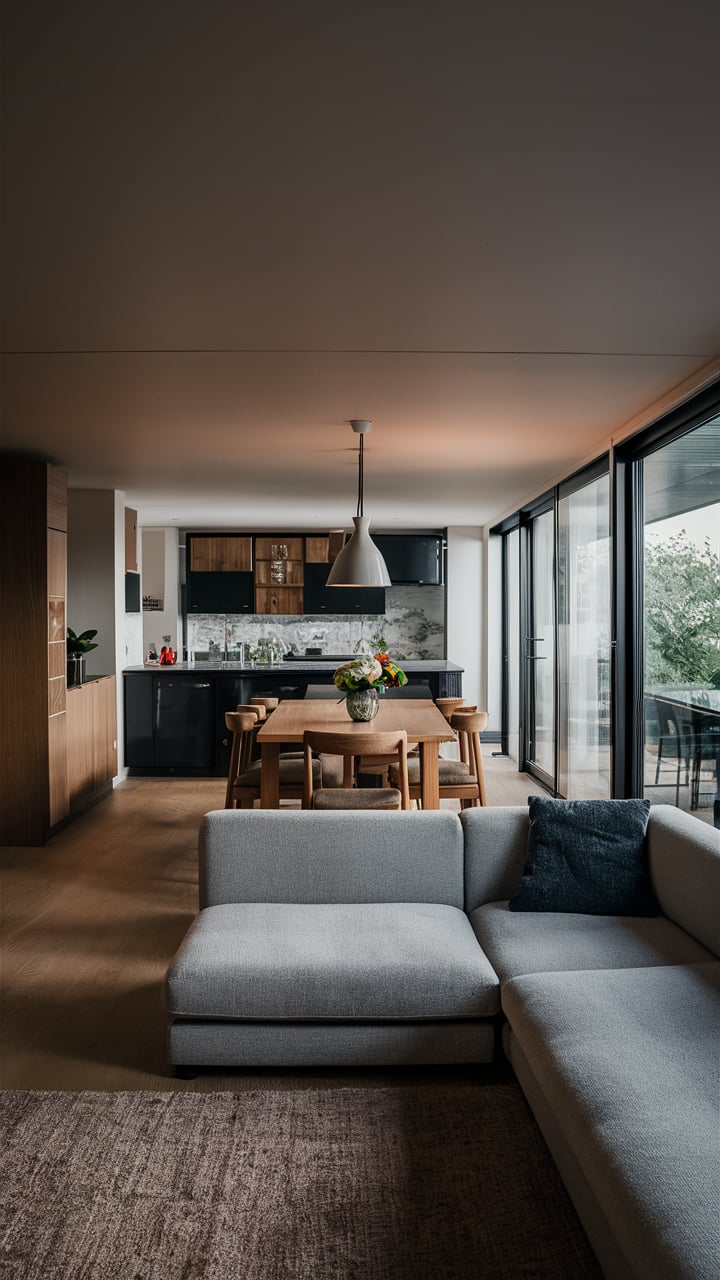
Position the L-shaped couch strategically to maximize its effectiveness. Face it towards the living area’s focal point, like a TV or fireplace. The couch’s extension should subtly separate the spaces while maintaining an open atmosphere.
This setup encourages natural flow between areas. It makes conversation and interaction easy, keeping the space inviting and functional.
Adding a Console Table for Definition
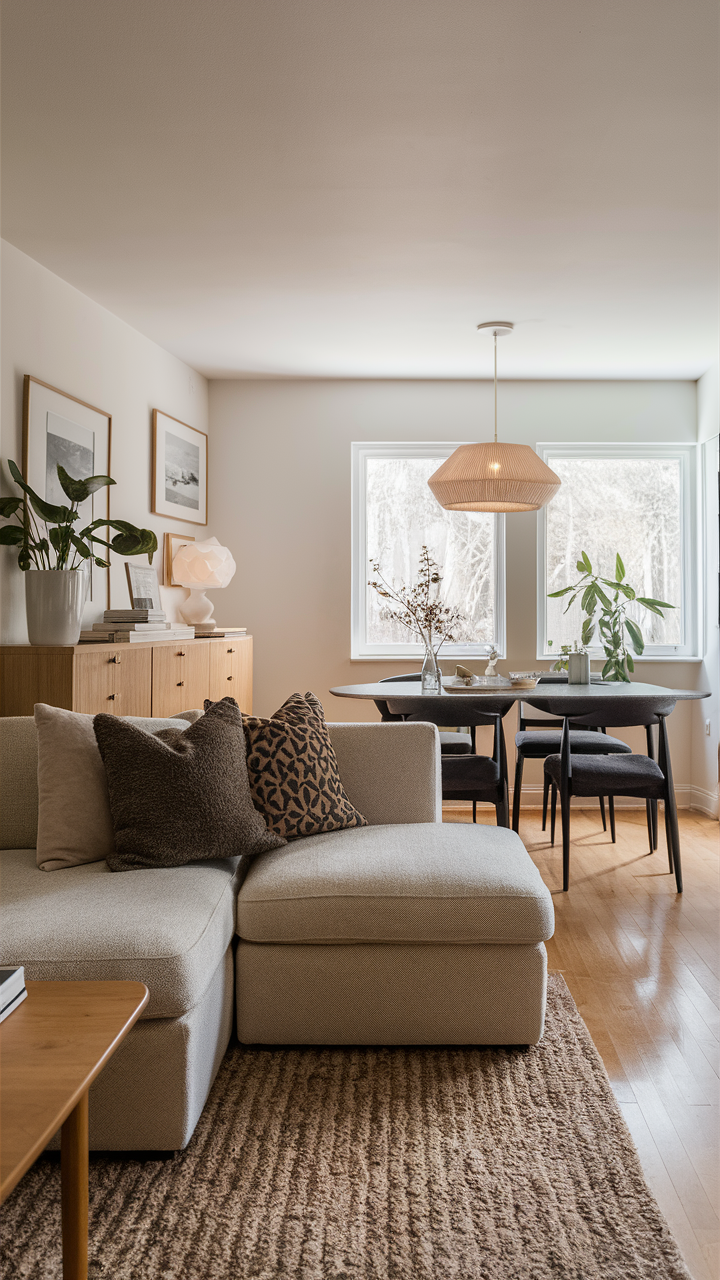
Place a console table behind the L-shaped couch to enhance separation. It provides a surface for decor, storage, or lighting. The table acts as a subtle barrier between living and dining areas.
This additional piece helps visually define the spaces. It reinforces the distinction without sacrificing the room’s openness.
An L-shaped couch and console table create a functional, inviting combo space. This setup maximizes available area, ensuring comfort and style. Your small living space will feel cohesive and spacious.
Choosing a Round Dining Table
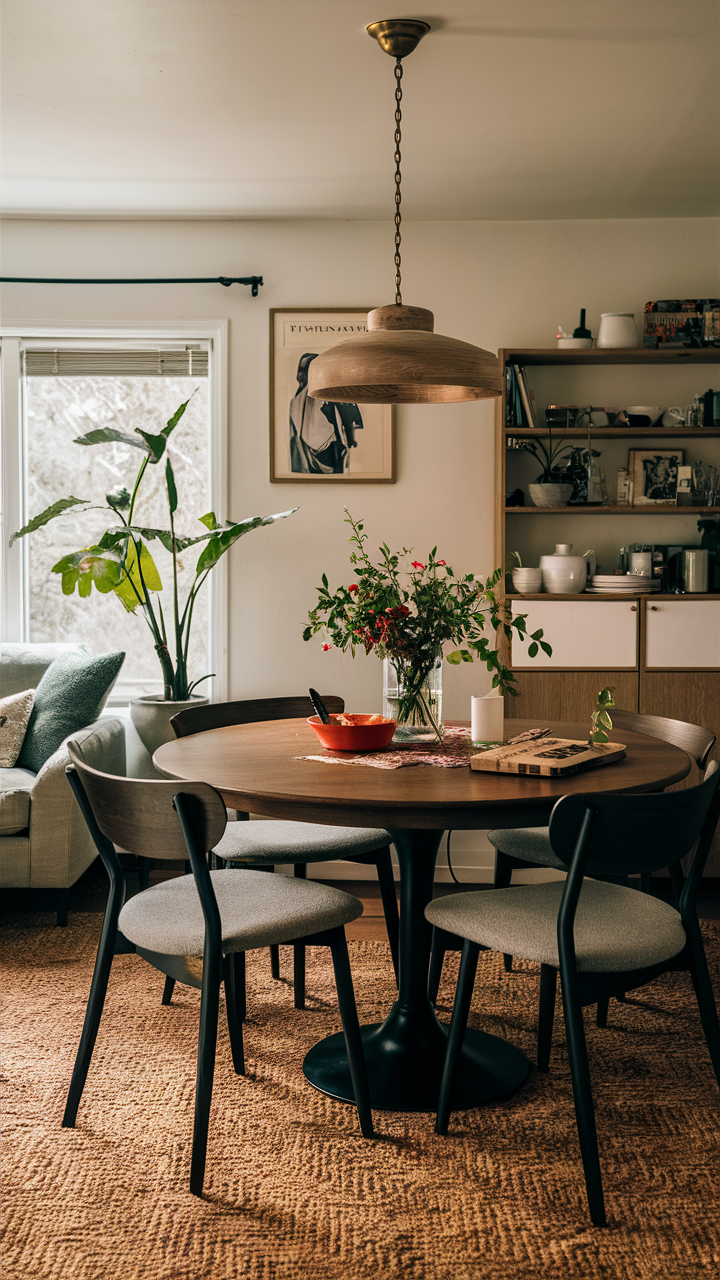
A round dining table is perfect for small living room dining combos. It creates an illusion of more space while fostering intimacy. Round tables make it easier to move around and promote better conversation.
The minimum width for a comfortable dining table is about 30 inches. This ensures guests don’t feel cramped while eating. Round tables also eliminate sharp corners, making navigation easier in tight spaces.
Maximizing Legroom with Pedestal Base
A round table with a pedestal base maximizes space in small combos. It provides more legroom and makes the room feel lighter. There are no table legs to interfere with seating arrangements.
Choose a sturdy pedestal base that supports the tabletop well. It should accommodate your regular number of diners comfortably. A well-designed base adds style and function to your space.
Selecting Chairs that Tuck In
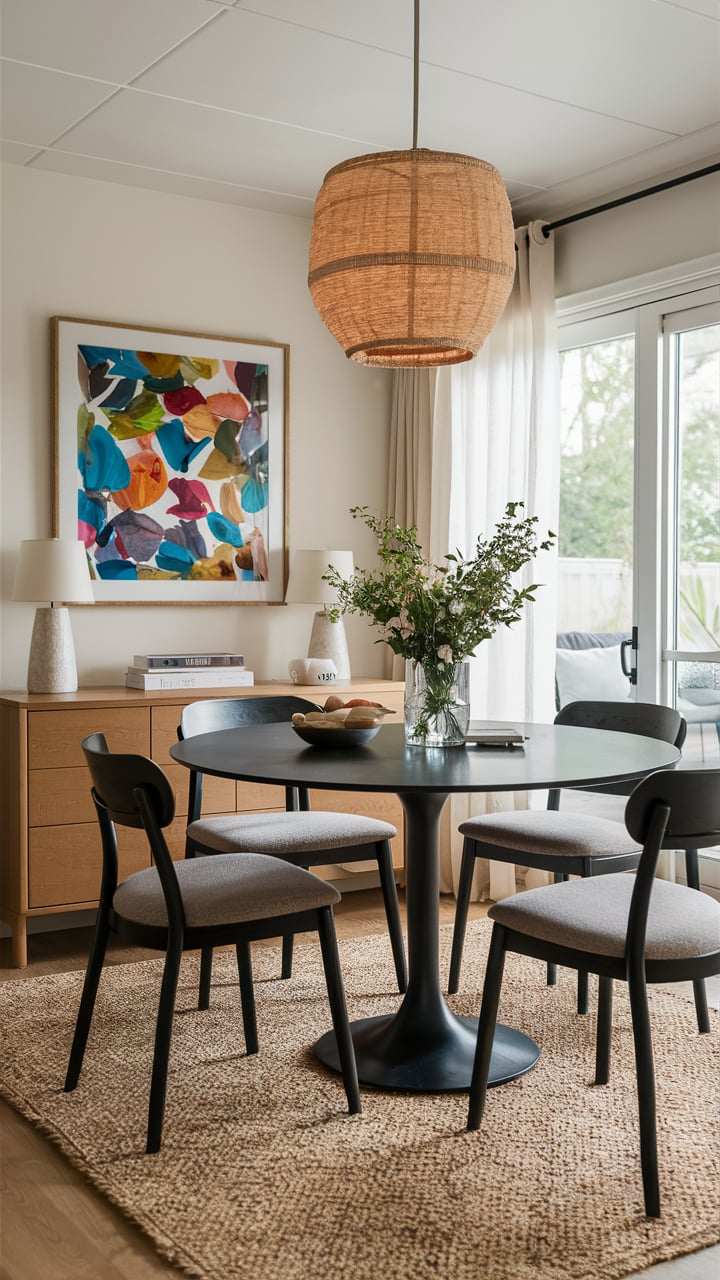
Pick chairs that tuck fully under the round table when not in use. This saves floor space and keeps your combo area clutter-free. Look for chairs with slim profiles and minimal armrests.
Opt for comfortable chairs with cushioned seats and supportive backs. This ensures pleasant meals and conversations. Chairs that tuck in seamlessly create a cohesive and inviting dining area.
Multipurpose Furniture Solutions
Multipurpose furniture is crucial for small living room dining combos. Ottomans with storage and seating are smart choices. They can be moved around as needed.
Adjustable coffee tables can transform into dining tables quickly. This versatility allows you to switch between living and dining areas effortlessly.
Choose furniture with hidden storage to reduce clutter. A sideboard can store dining items and display decorations. Select pieces that match your room’s style.
Other multipurpose furniture options include:
- A sofa bed that can accommodate overnight guests
- Nesting tables that can be expanded for dining or entertaining
- A storage bench that can be used as seating or a coffee table
- A drop-leaf table that can be folded down when not in use
Multipurpose furniture creates a stylish and functional space. It maintains comfort and practicality in small areas. Measure your room carefully before buying furniture.
Ensure new pieces fit your layout and improve room flow. This approach maximizes space and functionality in your combo room.
Maximizing Vertical Space
Small living room dining combos need smart use of vertical space. This maximizes storage and creates openness. By focusing upward, you can enhance functionality without sacrificing floor area.
Incorporating Wall-Mounted Shelves
Wall-mounted shelves are a great way to use vertical space. They can display books, decor, or plants. Install them above your dining table or along empty walls.
Choose shelves that match your decor style. Floating shelves work well for modern looks. Rustic wooden shelves add warmth to traditional spaces.
Utilizing Tall, Narrow Cabinets
Tall, narrow cabinets are perfect for small combo rooms. They store dining essentials and media items out of sight. This keeps your space tidy and clutter-free.
Consider cabinets with sliding or glass doors. These showcase decorative items while keeping them dust-free. Mix open shelving with closed storage for versatility.
Wall-mounted shelves and tall cabinets maximize vertical space effectively. They increase storage and create a more spacious feel. Choose finishes that match your existing furniture for a cohesive look.
Harnessing the Power of Mirrors
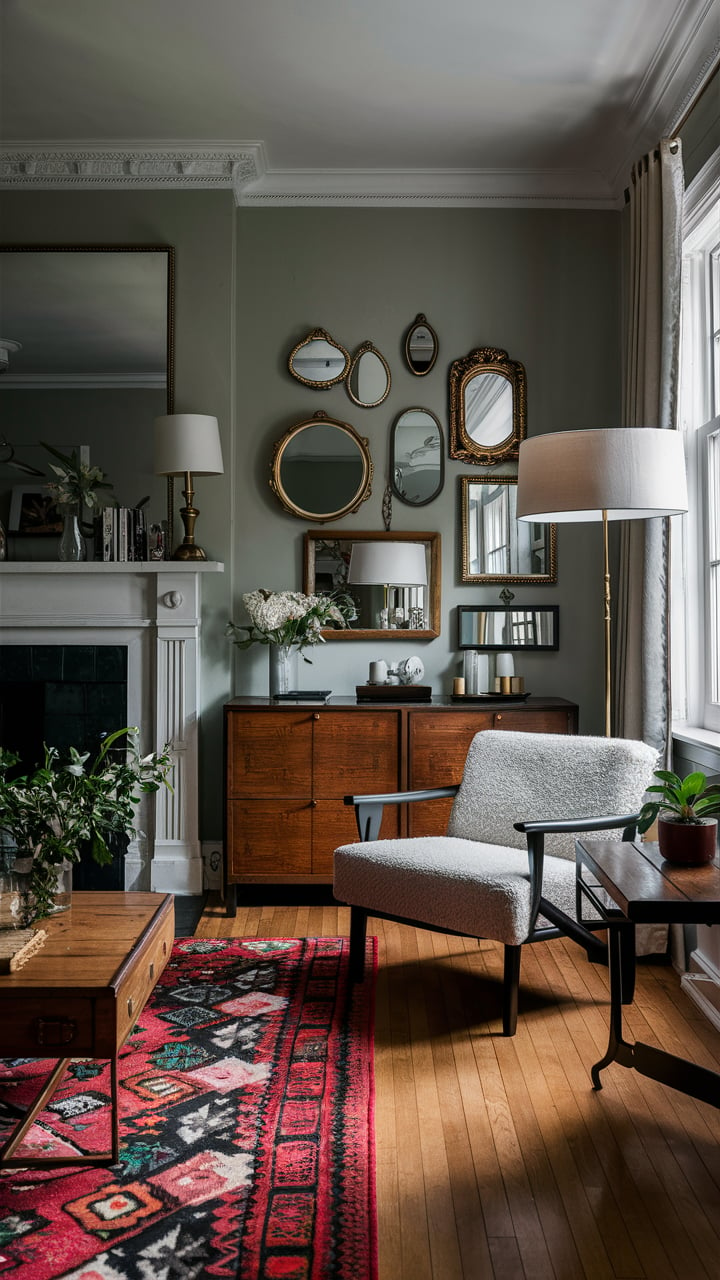
Mirrors are a designer’s secret weapon for making small spaces appear larger. They create depth, reflect light, and add decorative elements to enhance ambiance. Strategic mirror placement can transform your living room dining room combo.
Place a large floor mirror opposite a window to reflect natural light. This brightens the space and creates an open feel. Alternatively, position a mirror behind an accent chair or console table for added depth.
Layering multiple mirrors creates a stylish statement perfect for small spaces. This amplifies light reflection and adds visual interest. Choose mirror styles and frames that complement your room’s aesthetic, from antique to modern designs.
Mirrored furniture incorporates reflective surfaces without using wall space. Coffee tables, storage consoles, and dining tables with mirrored elements can create a larger room illusion. These pieces maintain functionality while enhancing the space.
The average mirror hanging height is 60 inches from floor to center. Experiment with different heights and placements for the best arrangement. Try leaning a mirror against a wall or placing one in front of a lamp.
Strategic mirror placement is key in small living room dining combos. Mirrors reflect light, create depth, and add decorative touches. They can make your space feel larger, brighter, and more inviting.
Implementing a Monochromatic Color Scheme
A monochromatic color scheme can create a cohesive look in a small living room dining room combo. It uses varying shades of a single hue to visually expand the space. This approach makes the area feel more open and unified.
The scheme doesn’t limit you to one paint color. It’s about blending similarly toned colors for depth and interest. Successful monochromatic rooms feature subtle variations of a specific color throughout the design.
Varying Shades for Depth and Interest
Use a range of shades within your chosen hue for a dynamic look. Start with a light gray in the living area and transition to darker gray in the dining space. This subtle shift helps define different functional zones without visual breaks.
Incorporate various shades through textiles, furniture, and decor pieces. Throw pillows, curtains, and rugs in different tones add texture and visual interest. Experiment with materials and finishes like matte, glossy, or metallic for a layered look.
Creating a Cohesive and Sophisticated Look
A monochromatic scheme can make a small combo room feel more cohesive and sophisticated. Using a consistent color palette creates visual harmony between living and dining areas.
Incorporate high-quality materials and finishes to enhance sophistication. A glass dining table with velvet chairs in a deep shade adds luxury. A plush, tufted sofa in a lighter shade creates a cozy living area.
Choose accessories intentionally to complement your color scheme. Add visual interest without overwhelming the space. A striking wall art piece or sculptural light fixture can elevate the overall design.
Playing with Textures
Adding textures to a small living room dining combo creates depth and interest. Combining different textures makes a rich, inviting space without overwhelming it with colors. This approach can make your room feel more spacious and engaging.
Pair soft upholstery with smooth wood finishes for contrast. Mix plush rugs with sleek metal accents and glossy surfaces with matte ones. Choose textures that match your color scheme and desired atmosphere.
Here are some tips for adding texture to your living room dining room combo:
- Use rugs with tassels or unique weaves to add visual interest and warmth underfoot.
- Incorporate weathered wood tables or shelving units to bring a rustic, natural element to the space.
- Choose ottomans or poufs in different materials like leather, velvet, or woven fabrics to provide additional seating and texture.
- Hang art pieces with texture, such as woven wall hangings, mixed media paintings, or sculptural elements, to draw the eye and create focal points.
- Layer throw pillows and blankets in various textures, like cable knits, faux fur, or linen, to make the seating area more inviting and comfortable.
- Incorporate natural elements like plants, driftwood, or stone accessories to add organic textures and bring a touch of the outdoors inside.
Mix textures to create a stylish and comfortable space. Experiment with different combinations to find your perfect balance. This will enhance the overall ambiance of your room.
Small Living Room Dining Room Combo Layout Ideas
Maximizing space is crucial in a small living room dining room combo. Smart layout strategies and functional furniture can transform limited square footage. You can create a stylish and efficient living area with the right approach.
Sliding or Folding Doors for Separation
Sliding or folding doors can separate your living room from the dining area. These space-saving solutions offer flexibility for intimate dinners or work hours. Choose glass for an open feel or solid doors for privacy.
Establishing Different Lighting Zones
Distinct lighting zones help define living and dining areas in a combo space. Install a pendant light or chandelier above the dining table. Use lamps and sconces in the living area for a cozy ambiance.
Incorporating Transparent Elements
Transparent furniture pieces maintain an open feel in small combo spaces. A glass dining table or clear acrylic chairs can visually expand the room. These elements allow light to pass through, creating a sense of spaciousness.
Utilizing Nested Tables
Nested tables are practical for small living room dining room combos. They serve as both coffee and dining tables when needed. Pull out smaller tables for extra dining space during larger gatherings.
Placing a Sofa Table Behind the Couch
A sofa table behind the couch can divide adjacent living and dining areas. This narrow table provides extra storage or display space. Use it for decorative items, lamps, or dining essentials like placemats.
Conclusion
Creating a functional, stylish small living room dining room combo isn’t impossible. With smart design solutions, you can maximize space and achieve a cohesive look. Use area rugs, floating furniture, and multipurpose pieces to define zones while maintaining flow.
Optimize your space with wall-mounted shelves and tall, narrow cabinets. Mirrors can make the area seem larger. A monochromatic color scheme adds sophistication, while textures provide depth and interest.
Consider sliding doors, different lighting zones, and transparent elements for separation and functionality. Nested tables and sofa tables behind the couch offer practical solutions. These components create a visually appealing space that maximizes every square foot.
FAQ
How can I distinguish between living and dining spaces in a small combo room?
Area rugs are a great way to separate living and dining areas. Pick rugs that match in color, texture, and style. This creates a unified look while defining different zones.
What is a floating furniture arrangement, and how does it help in a small living room dining room combo?
Floating furniture means placing sofas, chairs, and tables away from walls. This makes the room feel bigger and more open. It also allows for more flexible use of space.
Can an L-shaped couch work as a divider in a narrow living room dining room combo?
Yes, an L-shaped couch can divide a narrow living room dining room combo. Face the couch towards the living area’s focal point. Use the extension to subtly separate spaces without closing them off.
Why is a round dining table a good choice for a small combo space?
Round tables have no sharp corners, making them easy to move around. They create a cozy dining experience and encourage conversation. Choose a pedestal base and chairs that tuck in for more space.
What type of furniture should I look for in a small living room dining room combo?
Choose multipurpose furniture for small combo spaces. Look for ottomans with storage, adjustable coffee tables for dining, and sideboards that double as media consoles. This saves space and makes the room more adaptable.
How can I maximize storage in a small living room dining room combo without sacrificing floor space?
Use vertical space with shelving, tall cabinets, or hanging elements. Wall-mounted shelves and narrow cabinets add storage without taking up floor space. These options keep the room organized and add visual interest.
What role do mirrors play in designing a small living room dining room combo?
Mirrors are a great tool for small spaces. They reflect light, making rooms brighter and more open. Mirrors also add decoration and create depth, transforming the feel of the space.
How can a monochromatic color scheme benefit a small living room dining room combo?
A monochromatic color scheme unifies living and dining areas. It creates a smooth flow between spaces. Using different shades of one color adds depth and visually expands the room.
How can I add interest to a small combo space without overwhelming it with colors?
Play with textures to add depth without using too many colors. Mix soft upholstery, smooth wood, and plush rugs. Add sleek metal, glossy surfaces, and matte finishes for a rich, inviting look.
What innovative features can help separate living and dining areas in a small combo space?
Sliding or folding doors can separate areas on demand. They allow for an open feel during gatherings or privacy when needed. Try different lighting zones, transparent elements, and nested tables. Placing a sofa table behind the couch also helps divide spaces.
